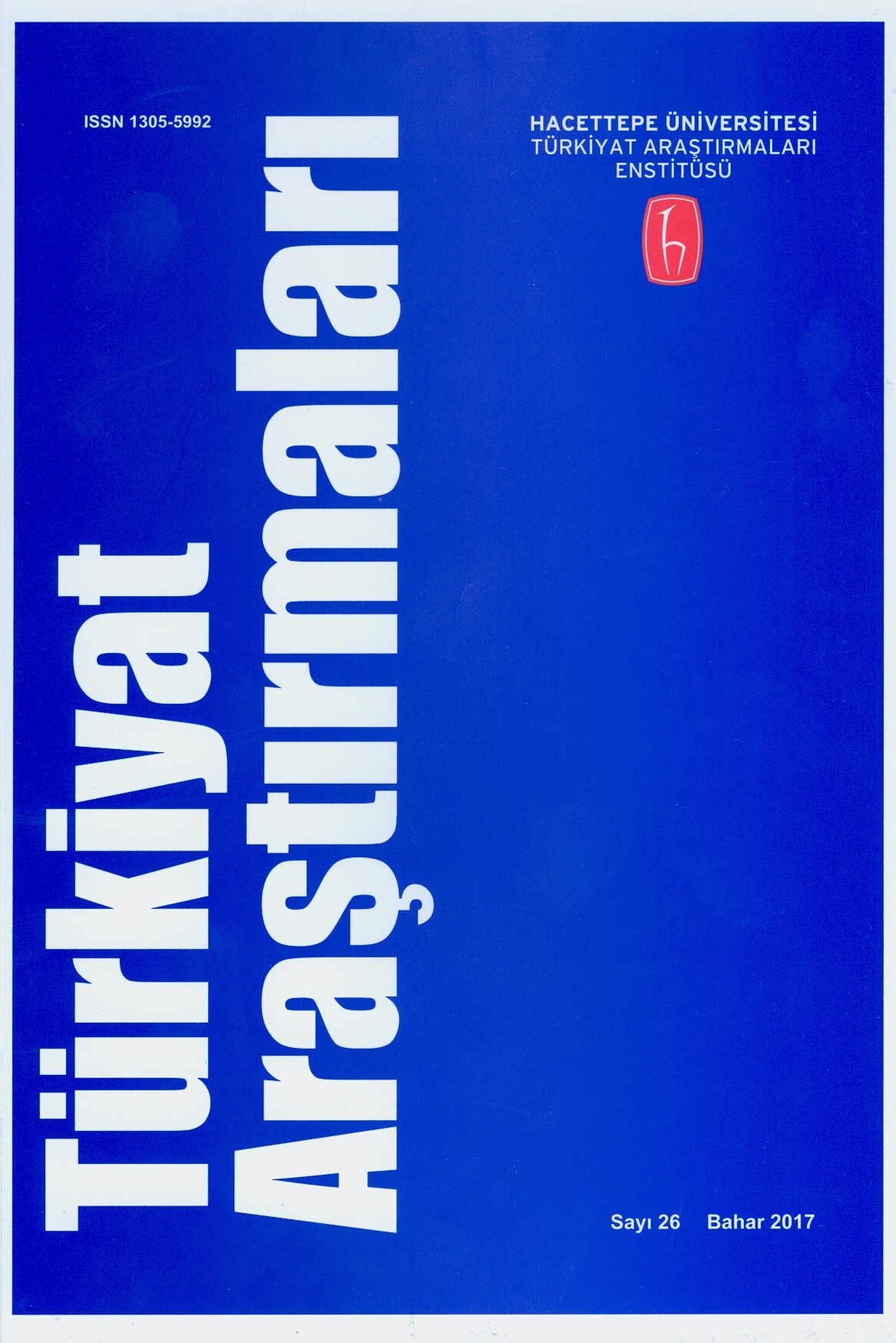Spora Katılımda Toplumsal Fayda: Kazakistan Ahmet Yesevi Üniversitesi Öğrencileri Örneği
Çalışmada, spora aktif katılımla kazanılan davranışlar, toplumsal fayda çerçevesinde ele alınmıştır. Spor bireye, topluma uyumu öğreten toplumsal kurumlardan biridir. Bu işlevi onun toplumsal fayda beklenen bir kurum olduğuna işaret etmektedir. Çalışma, Kazakistan’da Ahmet Yesevi Üniversitesi öğrencilerine anket formu uygulanarak yapılmıştır. Araştırma grubu, amaçlı örneklem çerçevesinde Spor ve Sanat Fakültesinin Spor Fakültesi ile diğer fakülte öğrencilerinden, spora sürekli ve aktif katılanlar arasından oluşturulmuştur. Çalışmada, öğrencilerin spora aktif katılımı ile toplumsal fayda sağlama arasındaki ilişkinin düzeyi sorgulanmıştır. Uygulanan anket sonucu elde edilen verilerden, sporun kişiye toplumsal ve bireysel davranışlar kazandırdığı ve şiddeti kontrol etmeyi öğrettiği görülmüştür. Kazakistan’da Ahmet Yesevi Üniversitesi öğrencileri ile yapılan bu çalışmada, spora erken yaşta aile üyeleri ve okul yöneticilerinin teşviki ile başlanmasının toplumda bir değer oluşturduğu ve buradan hareketle de sporun, toplumsal fayda sağlamaya yönelik işlevi olduğu sonucuna ulaşılmıştır.
Anahtar Kelimeler:
Spor, sosyalizasyon, toplumsal fayda, spor kültürü, spora katılım
___
- Arslan, Y. ve Bulgu, N. (2010). Oyunla Toplumsallaşma. Pamukkale Journal of Sport Sciences, 1(1), 8-22.
- Birchwood, D., Roberts, K. and Pollock, G. (2008). Explaining Differences in Sport Participation Rates Among Young Adults: Evidence from the South Caucasus. European Physical Education Review, 14, 283.
- Bottomore, T. ve Nispet, R. (1990). Yapısalcılık (B. Toprak, Çev.). Sosyolojik Çözümlemenin Tarihi içinde (ss. 572-613), T. Bottomore, R. Nispet (Der.). Ankara: Verso Yayıncılık,
- Bourdieu, P. (2002). Distinction – A Social Critique of Judgement of Taste (R. Nice, Trans.). Eleventh printing, London:Routladge.
- Breuer, C., Hallmann, K. and Wicker, P. (2011). Determinants of Sport Participation in Different Sports. Managing Leisure, 16, 269–286.
- Bulgu, N. ve Akcan, F. (2003). Spor ve Toplumsallaşma. Beden Eğitimi ve Sporda Sosyal Alanlar Sempozyumu, 10-11 Ekim, 2003, Ankara.
- Bulgu, N., Koca, A. C. ve Aşçı, F.H. (2007). Gündelik Yaşam, Kadın ve Fiziksel Aktivite. Spor Bilimleri Dergisi, 18(4), 167-181.
- Carrington, B. and McDonald, I. (2006). The Politics of ‘Race’ and Sport Policy, Sport and Society. A Student Introduction (B. Houlihan, Ed.) içinde (ss. 125-142). London: Sage Publications.
- Coackley, J. (2007). Sport and Society, Issues and Controversies. USA: McGraw Hill.
- Giddens, A. (2005). Sociology (4th ed.). UK: Polity Pres.
- Grenfell, C. C. and Rinehart, R. E. (2003). Skating on the Thin Ice, Human Rights in Youth Figure Skating. International Review for the Sociology of Sport, 38 (1), 79-97.
- Hargreaves, J. (1994). Sporting Females: Critiqual Issues in the History and Sociology of Women’s Sport. London, Routledge.
- Horne, J., Tomlinson, A. and Whannel, G. (1999). Understanding Sport, An Introduction to the Sociological and Cultural Analysis of Sport. London: Spon Pres.
- Huizinga, J. (1995). Homo Ludens. Oyunun Toplumsal İşlevi Üzerine Bir Deneme (M. A. Kılıçbay, Çev.). İstanbul: Ayrıntı Yayınları.
- Kay, T. (2006). Sport and Gender, Sport and Society. A Student Introduction (B. Houlihan, Ed.) içinde (ss. 89-104), London: Sage Publications.
- Kay, T. and Spaaij, R. (2011). The Mediating Effects of Family on Sport in Iinternational Development Contexts. International Review for the Sociology of Sport, 47 (1), 77–94.
- Kirk, D. and MacPhail, A. (2003). Social Positioning and the Construction of a Youth Sports Club. International Review for the Sociology of Sport, 38(1), 23–44.
- Koca, C., Henderson, K. A., Aşçı, F.H., and Bulgu, N. (2009). Constraints to Leisure-Time Physical Activity and Negotiation Strategies in Turkish Women. Journal of Leisure Research, 41 (2), 225-251.
- Loy, J.W. JR. (1969). The Nature of Sport, Sport Culture and Society. A Reader on the Sociology of Sport (J.W.Loy and G.S. Kenyon, Ed.) içinde (ss. 56-70), USA: The Macmillan, Company.
- Loy, J.W. JR., McPherson, B. D. and Kenyon, G. (1978). Sport and Social Systems, A Guide to the Analysis, Problems, and Literature. Calfornia: Addison-Wesley Publishing Company.
- MacPhail, A. and Kirk, D. (2006). Young People’s Socialisation into Sport: Experiencing the Specialising Phase. Leisure Studies, 25(1), 57–74.
- Mechikoff, R.A. and Estes, S.G. (2002). A History and Philosophy of Sport and Physical Education, From Ancient Civilizations to Modern World. (Third Ed), USA: McGrawHill.
- McNeill, P. and Chapmann, S. (2005). Research Methods. (Third Ed.), USA, Routledge.
- McPherson, B. D., Curtis, J. E. and Loy, J. W. (1989). The Social Significance of Sport, an Introduction to the Sociology of Sport. USA: Human Kinetics Boks.
- Seippel, Ø. (2006). The Meanings of Sport: Fun, Health, Beauty or Community?. Sport in Society, 9(1), 51–70.
- Smith, E. and Hattery, A. J. (2006). Hey Stud: Race, Sex, and Sport. Sexuality & Culture, 10(2), 3-32.
- Vermeulen, J. and Verweel, P. (2009). Participation in Sport: Bonding and Bridging as Identity Work. Sport in Society, 12(9), 1206–1219.
- Weber, R. (2009). Protection of Children in Competitive Sport, Some Critical Questions for London 2012. International Review for the Sociology of Sport, 44(1), 55–69.
- Wheeler, S. (2011). The Significance of Family Culture for Sports Participation. International Review for the Sociology of Sport, 47(2), 235–252.
- http://tr.wikipedia.org/wiki/Kategori:Olimpiyat_Oyunlar%C4%B1%27nda_Kazakistan adresinden 2 Kasım 2012 tarihinde erişildi.
- http://www.yesevi.edu.tr adresinden 9 Ağustos 2012 tarihinde erişildi.
- ISSN: 1305-5992
- Yayın Aralığı: Yılda 2 Sayı
- Başlangıç: 2004
- Yayıncı: Hacettepe Üniversitesi
Sayıdaki Diğer Makaleler
Geçmişin Yeniden İnşası: Târîh-i Sultân Selîm Han ve Tasvirleri
Şark Meselesinden Bir Kesit: Osmanlı-Rus İlişkilerinde Eflâk-Boğdan Meselesi (1864-1865)
Osmanlıların Modern Teknoloji ile Karşılaşması: Elektrik Örneği
Spora Katılımda Toplumsal Fayda: Kazakistan Ahmet Yesevi Üniversitesi Öğrencileri Örneği
Mükerrer Suçluların Sosyo-Kültürel Özellikleri: Çanakkale E Tipi Kapalı Ceza İnfaz Kurumu Örneği
